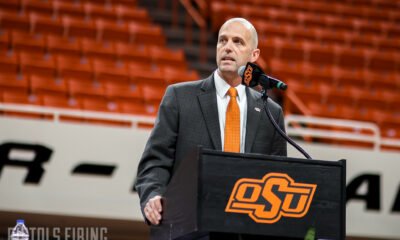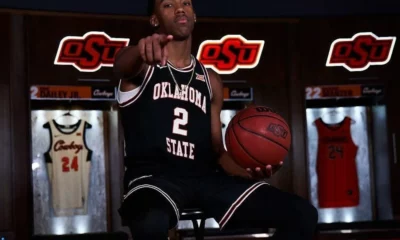Recruiting
Do the New College Football Recruiting Rules Help or Hurt Oklahoma State?

Several new rules were implemented last week to help govern college football recruiting. You can read about all of those more in-depth here. You may or may not have heard about these rules, but they certainly affect the future (and Oklahoma State) in ways we can’t foresee yet. “If it goes through,” Big 12 commissioner Bob Bowlsby told CBS Sports of the bundling of rules, “it will be the most impactful piece of football recruiting legislation in 25 years.”
The new rules require a final stamp of approval from the NCAA Board of Directors at the end of April, but that is likely a formality. So while you might not care about how 18-year-olds are treated by colleges on a national level, you probably do care about how this impacts the mulleted man in Stillwater, OK. Let’s go through each rule, and I’ll give my opinion on whether it helps or hurts Oklahoma State.
1. Early Signing Period
The new rule is that there will be a three-day December signing period before the big one in February. I have written before about exactly how this helps a school like Oklahoma State vs., say, an Ohio State. The Cowboys are often copy/pasted by bigger schools when it comes to recruits they suss out.
Schools seem to value #OkState evaluations. Cowboys offer Kanion Williams yesterday. 4 more offer this morning: https://t.co/zojbQivndN
— Brian Perroni (@Perroni247) March 28, 2017
A December signing period won’t change this as much as, say, a July or August one, but it will certainly help. The reality in college football is that there is a pecking order when it comes to offers. If OU loses a defensive back the week before National Signing Day to school like Florida State, and Oklahoma State has the top DB recruit in the state of Oklahoma (but that recruit didn’t have an offer from OU), guess what’s happening there?
Now, that will no longer happen as much as it might have (although it will still happen some). Think about all the players that were flipped between the end of the CFB season and NSD in February last year. Texas, Texas A&M and other schools swiped OSU’s players out from underneath the protection of Gundy’s mullet. That doesn’t mean those players would have signed in December if this rule was in place, but at least it would have been an option.
Verdict: Helps
2. A 10th assistant coach
Kyle Cox is going to write more about this later on this week, but Mike Gundy’s emphasis on special teams will likely be aided by the addition of a 10th assistant. Future archaeologists of college football history will likely think 10 assistants to be excessive, but it makes sense in the moment.
Verdict: Helps
3. Hire Friends/Family/Coaches of Recruits
Schools would no longer be allowed to hire (No. 1 recruit’s uncle) to wash arm sleeves in the equipment room as to lure (No. 1 recruit] to (college). This is a good thing, but it doesn’t much affect OSU unless Justice Hill’s dad is handing out helmet decals and we don’t know about it. Because OSU doesn’t really do this, I guess I lean towards (mildly) helping.
Verdict: Helps
4. Junior Year Officials
As of now, recruits are not allowed to take their five official visits until their senior year. This legislation would bump that back to April of their junior year. Andy Staples of Sports Illustrated pointed out why this could help the Oklahoma States and Nebraskas of the world (both of which are in the middle of nowhere).
This rule could be a godsend for programs such as Nebraska that are located far from recruiting hotbeds. While schools near such hotbeds could get recruits to make short drives to take unofficial visits, the Nebraskas and Syracuses of the world struggled to convince players to pay their own way to come for an unofficial visit or to a camp. And since much of a cycle’s players are committed by August, this gave those schools little chance to show off their programs.
Now, those schools can bring in a player in April, May or June. If he likes what he sees, that player may then decide to pay his own way back for camp or for a game in the fall. But at least those schools will have a more equal chance to show what they have to offer before most recruits narrow their options. [Sports Illustrated]
Verdict: Helps
5. Satellite Camp Limitations
Satellite camps will now be limited to 10 days in June and July and must he held on a college campus. Oklahoma State has long been a proponent of these camps — I think Mike Gundy thinks he invented them — and this is not great news for a school like OSU that struggles (relatively) in recruiting. Still, it’s better than the complete ban that was enacted last year after Jim Harbaugh plastered his name all over the satellite-touring world.
Here is Staples again.
Programs now may use 10 days in June and July to hold camps, but those camps must be held on a college campus. That means multiple staffs may still work together to host a camp at a school near a recruiting hotbed, but a staff such as Michigan couldn’t take off on a monthlong world tour. [Sports Illustrated]
This won’t hurt OSU monumentally, but it is a baby step back from what it was doing which was essentially a tour de Texas in the summer to find the James Washingtons and Jordan Sterns’ of the recruiting world.
Verdict: Hurts
6. No more Two-a-Days
Gundy started this many, many years ago. I think limiting two-a-days actually hurts Oklahoma State because I think two-a-days hurt teams, and OSU was already not doing them. It is humorous to me that a man who hunts rattlesnakes was blazing a trail a decade ago that the NCAA is just now following. Otherwise, this is (very minimally) bad for OSU.
Verdict: Hurts
7. Classes limited to 25 players
Only a handful of schools ever really over-signed, and it was a shady business. Oklahoma State was not one of them, but what did often happen is that it would fill only 18-19 spots in one class and then 26-27 in the next. Classes in the future will be more balanced in terms of pure numbers, although I’m not sure this really helps or hurts anyone. I suppose more great players will be available for the taking if Alabama is not signing 45 guys every time around.
Verdict: Helps
Overall, most of the reform here is beneficial to a non-recruiting powerhouse like Oklahoma State. These rules were implemented, presumably, to help kids make better decisions about college and give them more power, but the unintended consequences here seem to be that the NCAA has thrown the Oklahoma States and Texas Techs of the world a life preserver.
The advantages are minimal, sure, but so is the line in recruiting between having the 33rd-best class and the 22nd. Hopefully this will help OSU start inching away from the former and towards the latter.

-

 Football3 days ago
Football3 days agoFour-Star Quarterback Adam Schobel Commits to Oklahoma State, Flips from Baylor
-

 Hoops3 days ago
Hoops3 days ago‘Keep Turning Over the Rocks’: Looking at the Portal Landscape as Lutz Looks to Solidify His First OSU Roster
-

 Hoops3 days ago
Hoops3 days agoFour-Star Signee Jeremiah Johnson Reaffirms Commitment to Oklahoma State after Coaching Change
-

 Daily Bullets3 days ago
Daily Bullets3 days agoDaily Bullets (Apr. 23): Pokes Land Four-Star Quarterback, Retain Talent from Mike Boynton Era






